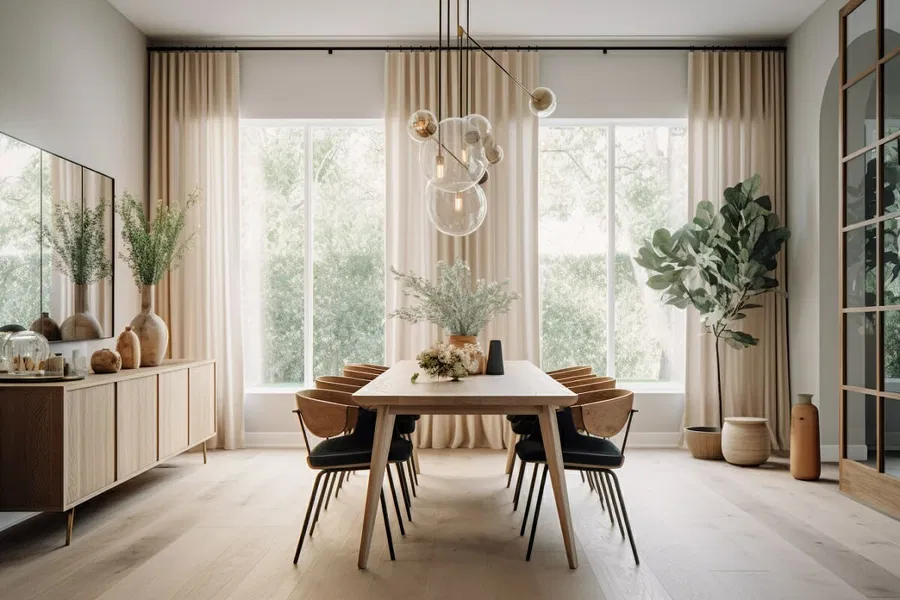A well-designed dining area serves as the heart of a home, bringing together family and friends for meals, conversations, and special occasions. Whether you have a spacious dining room or a compact dining nook, achieving the perfect balance between style and functionality is essential. With thoughtful planning, you can create a space that is both inviting and practical, catering to both everyday meals and entertaining guests.
Defining Your Dining Space
Before selecting furniture and décor, it’s important to define the purpose of your dining area. Are you designing a formal space for dinner parties, or do you need a casual, multifunctional area that suits daily meals and other activities? Understanding how you intend to use the space will help you make design choices that align with your lifestyle.
For open-concept homes, consider creating a visual separation between the dining area and other living spaces using rugs, lighting, or a distinct wall treatment. In smaller homes or apartments, opt for space-saving solutions like extendable tables or built-in seating to maximize functionality without compromising style.
Choosing the Right Dining Set
The dining set is the focal point of any dining area, setting the tone for the overall aesthetic. When selecting a dining table and chairs, consider both form and function. The table should be large enough to accommodate your household while fitting comfortably within the space. Rectangular tables work well for larger rooms, while round or oval tables are ideal for smaller areas, offering a more intimate setting.
Chairs should complement the table while providing comfort for long meals and gatherings. Upholstered chairs add a touch of luxury, while wooden or metal chairs bring a more minimalist appeal. If flexibility is a priority, mix-and-match seating options, such as a combination of chairs and a bench, can add character while optimizing space.
Optimizing Layout and Flow
Arranging your dining furniture to maximize space and movement is crucial. Ensure there is enough clearance around the table for people to sit and move comfortably. A general rule of thumb is to leave at least 36 inches of space between the table and the surrounding walls or furniture.
In open layouts, positioning the dining area near a window or natural light source can enhance the ambiance while making the space feel larger. Additionally, anchoring the area with a stylish rug can define the space and add warmth.
Lighting to Enhance Ambiance
Lighting plays a key role in setting the mood of a dining area. A statement chandelier or pendant light above the table can act as both a functional fixture and a decorative element. For a well-balanced lighting scheme, layer different sources of light, such as wall sconces or floor lamps, to provide ambient illumination.
Dimmable lighting allows you to adjust brightness levels depending on the occasion. Brighter lighting is ideal for casual meals and family activities, while softer lighting creates an intimate setting for dinner parties or special occasions.
Incorporating Storage and Versatility
A stylish dining area should also be practical, with ample storage solutions to keep essentials organized. Sideboards, buffets, or display cabinets can store dinnerware, linens, and serving pieces while also serving as a decorative focal point. If space is limited, consider a console table that can double as a serving station when entertaining.
For those who use the dining area for multiple purposes, such as working from home or crafting, furniture with dual functions can be a game changer. A table with hidden storage or stackable chairs provides flexibility, ensuring the space remains tidy and efficient.
Selecting Colors and Materials
The color palette and materials you choose will influence the overall style of your dining area. Neutral tones create a timeless and elegant atmosphere, while bold colors can add personality and vibrancy. If you prefer a modern aesthetic, sleek finishes like glass and metal can create a contemporary feel, whereas natural wood and textured fabrics offer a warm and inviting touch.
When selecting materials, prioritize durability, especially if the space will see frequent use. Easy-to-clean surfaces, stain-resistant upholstery, and scratch-resistant finishes will ensure your dining area remains stylish and functional for years to come.
Personalizing with Décor and Accessories
Adding personal touches to your dining area can elevate its charm and make it uniquely yours. Centerpieces, artwork, and decorative accents can enhance the ambiance while reflecting your personal style. Consider a statement vase with fresh flowers, a curated collection of framed prints, or a mix of candles and greenery for an inviting look.
Table settings, such as placemats, runners, and dinnerware, can also enhance the overall aesthetic. Changing these elements seasonally allows you to refresh the space without making major changes.
Maintaining a Clutter-Free Space
A well-designed dining area should feel open and inviting rather than overcrowded. Keep unnecessary items off the table and ensure storage solutions are effectively utilized. Regularly decluttering and maintaining a clean environment will make the space more enjoyable and functional.
For smaller dining areas, opting for minimal décor and streamlined furniture can create a more spacious feel. Mirrors can also help reflect light and create the illusion of a larger room.
Conclusion
Designing a dining area that is both stylish and functional requires a thoughtful balance of aesthetics, comfort, and practicality. By carefully selecting the right furniture, optimizing layout and lighting, and incorporating personal touches, you can create a space that serves as the perfect setting for meals, gatherings, and everyday moments. Whether you prefer a modern, traditional, or eclectic style, a well-designed dining area can enhance your home and lifestyle effortlessly.

